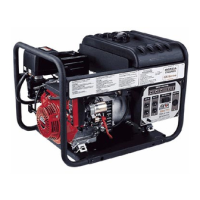Power Load Planning & Management
11
NEVER exceed the rated wattage capacity of your generator.
OVERLOADING may cause SERIOUS DAMAGE to the generator and
attached electrical devices, and may result in fire.
Your generator MUST BE SIZED PROPERLY to provide both the running and starting (surge)
wattage of the devices you will be powering. Before using your generator, determine the running
and starting wattage requirements of all the electrical devices you will be powering simultaneously.
The sum of the running and starting wattages of the devices being powered must not exceed the
continuous output rating of your generator. (The continuous output rating of your generator is listed
in the "Specifications" section of this manual.) Note that:
Devices without electric motors such as light bulbs, radios, and televisions have the same
running and starting wattage.
Devices with electric motors such as refrigerators, compressors, and hand tools typically
require a starting wattage that is 3 to 5 times greater than the running wattage.
The running and starting wattage requirements are often listed on a device's nameplate. If wattage
is not given on the device's nameplate, the wattage may be calculated by multiplying the nameplate
voltage by nameplate amperage, Watts = Volts X Amps.
Example conversion to watts:
120 Volts X 5 Amps = 600 Watts
If only the running voltage is given on the nameplate for a device with an electric motor, the starting
wattage can be approximated to be three to five times the running wattage.
Estimates for the running wattage requirements for common devices are listed in Table 1 below.
Guidance for starting wattages is provided in the table's footnotes.
Table 1
Air conditioner (12.000 BTU)
Oil-fired space heater (140,000 Btu)
Oil-fired space heater (85,000 Btu)
Oil-fired space heater (30,000 Btu)
Paint sprayer, Airless (1/3 HP)
Paint sprayer, Airless (handheld)
Electric range (1 element)
Submersible pump (1-1/2 HP)

